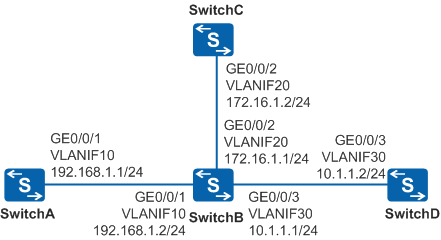Example for Configuring Basic RIP Functions
Networking Requirements
In Figure 1, SwitchA, SwitchB, SwitchC, and SwitchD are located on a small-sized network and need to communicate with each other.
Configuration Roadmap
RIP-2 is recommended if the network size is small. The configuration roadmap is as follows:
Configure VLAN and IP address for each interface to ensure network reachability.
Enable RIP on each switch to implement network connections between processes.
Configure RIP-2 on each switch to improve RIP performance.
Procedure
- Configure VLANs and add interfaces to the
VLANs. The configurations of SwitchB, SwitchC,
and SwitchD are similar
to the configuration of SwitchA, and are not mentioned here.
<HUAWEI> system-view [HUAWEI] sysname SwitchA [SwitchA] vlan 10 [SwitchA-vlan10] quit [SwitchA] interface gigabitethernet 0/0/1 [SwitchA-GigabitEthernet0/0/1] port link-type trunk [SwitchA-GigabitEthernet0/0/1] port trunk allow-pass vlan 10 [SwitchA-GigabitEthernet0/0/1] quit
- Configure an IP address to each VLANIF interface. The configurations
of SwitchB, SwitchC, and SwitchD are similar to the configuration
of SwitchA, and are not
mentioned here.
[SwitchA] interface vlanif 10 [SwitchA-Vlanif10] ip address 192.168.1.1 24 [SwitchA-Vlanif10] quit
- Configure basic RIP functions.
# Configure SwitchA.
[SwitchA] rip [SwitchA-rip-1] network 192.168.1.0 [SwitchA-rip-1] quit
# Configure SwitchB.
[SwitchB] rip [SwitchB-rip-1] network 192.168.1.0 [SwitchB-rip-1] network 172.16.0.0 [SwitchB-rip-1] network 10.0.0.0 [SwitchB-rip-1] quit
# Configure SwitchC.
[SwitchC] rip [SwitchC-rip-1] network 172.16.0.0 [SwitchC-rip-1] quit
# Configure SwitchD.
[SwitchD] rip [SwitchD-rip-1] network 10.0.0.0 [SwitchD-rip-1] quit
# Check the RIP routing table of SwitchA.
[SwitchA] display rip 1 route Route Flags : R - RIP A - Aging, G - Garbage-collect ---------------------------------------------------------------------------- Peer 192.168.1.2 on Vlanif10 Destination/Mask Nexthop Cost Tag Flags Sec 172.16.0.0/16 192.168.1.2 1 0 RA 14 10.0.0.0/8 192.168.1.2 1 0 RA 14The command output shows that the routes advertised by RIP-1 use natural masks.
- Configure the RIP version.
# Configure RIP-2 on SwitchA.
[SwitchA] rip [SwitchA-rip-1] version 2 [SwitchA-rip-1] quit
# Configure RIP-2 on SwitchB.
[SwitchB] rip [SwitchB-rip-1] version 2 [SwitchB-rip-1] quit
# Configure RIP-2 on SwitchC.
[SwitchC] rip [SwitchC-rip-1] version 2 [SwitchC-rip-1] quit
# Configure RIP-2 on SwitchD.
[SwitchD] rip [SwitchD-rip-1] version 2 [SwitchD-rip-1] quit
- Verify the configuration.
# Check the RIP routing table of SwitchA.
[SwitchA] display rip 1 route Route Flags : R - RIP A - Aging, G - Garbage-collect ---------------------------------------------------------------------------- Peer 192.168.1.2 on Vlanif10 Destination/Mask Nexthop Cost Tag Flags Sec 172.16.1.0/24 192.168.1.2 1 0 RA 32 10.1.1.0/24 192.168.1.2 1 0 RA 32From the routing table, you can find that the routes advertised by RIP-2 contain more accurate subnet masks.
Configuration Files
SwitchA configuration file
# sysname SwitchA # vlan batch 10 # interface Vlanif10 ip address 192.168.1.1 255.255.255.0 # interface GigabitEthernet0/0/1 port link-type trunk port trunk allow-pass vlan 10 # rip 1 version 2 network 192.168.1.0 # return
SwitchB configuration file
# sysname SwitchB # vlan batch 10 20 30 # interface Vlanif10 ip address 192.168.1.2 255.255.255.0 # interface Vlanif20 ip address 172.16.1.1 255.255.255.0 # interface Vlanif30 ip address 10.1.1.1 255.255.255.0 # interface GigabitEthernet0/0/1 port link-type trunk port trunk allow-pass vlan 10 # interface GigabitEthernet0/0/2 port link-type trunk port trunk allow-pass vlan 20 # interface GigabitEthernet0/0/3 port link-type trunk port trunk allow-pass vlan 30 # rip 1 version 2 network 192.168.1.0 network 172.16.0.0 network 10.0.0.0 # return
SwitchC configuration file
# sysname SwitchC # vlan batch 20 # interface Vlanif20 ip address 172.16.1.2 255.255.255.0 # interface GigabitEthernet0/0/2 port link-type trunk port trunk allow-pass vlan 20 # rip 1 version 2 network 172.16.0.0 # return
SwitchD configuration file
# sysname SwitchD # vlan batch 30 # interface Vlanif30 ip address 10.1.1.2 255.255.255.0 # interface GigabitEthernet0/0/3 port link-type trunk port trunk allow-pass vlan 30 # rip 1 version 2 network 10.0.0.0 # return
